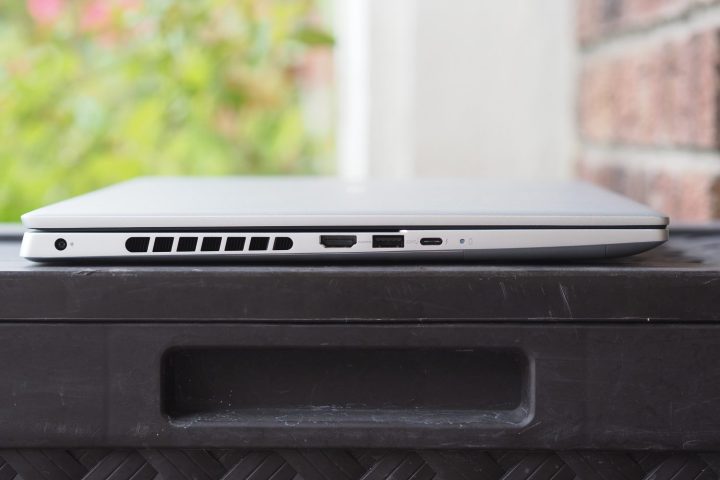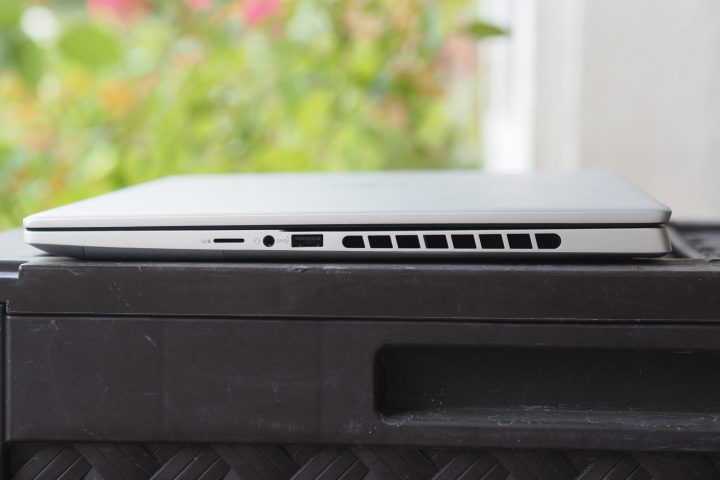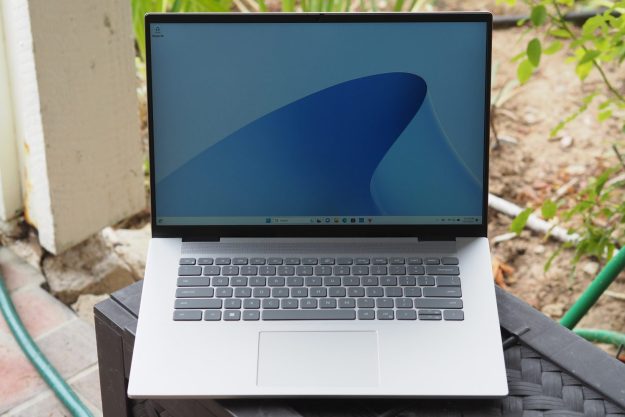
“It does everything a laptop needs to, but Dell’s Inspiron 16 Plus can’t pull off the premium presentation its price demands.”
- Excellent productivity performance
- Competent creativity performance
- Very good productivity display
- Lightweight for its size
- All-plastic build with some flexing and bending
- Not competitively priced
- No display option for creators
I’ve reviewed a few 16-inch laptops lately, which should come as no surprise. With the rise of creators as an important class of laptop users, manufacturers are focusing on providing large, fast laptops that meet their photo editing and video editing needs. While premium laptops have dominated that new breed, a few less expensive machines have made their way to the market. The Dell Inspiron 16 Plus is one example, offering fast CPUs, discrete GPUs, and large displays that should make creative work more productive.
But the Inspiron tends to represent Dell’s budget and midrange lineup, so putting a premium price on the Inspiron 16 Plus means it has to deliver. And it does when it comes to performance, but its design doesn’t live up to its price. It’s not a bad laptop, but there are some better options.
Specs and configurations
| Dell Inspiron 16 Plus | |
| Dimensions | 14.05 inches x 9.92 inches x 0.67-0.79 inches |
| Weight | 4.54 pounds |
| Processor | Intel Core i7-13620H
Intel Core i7-13700H |
| Graphics | Nvidia GeForce RTX 3050
Nvidia GeForce RTX 4050 Nvidia GeForce RTX 4060 |
| RAM | 8GB DDR5 (RTX 4060)
16GB LPDDR5 16GB DDR5 (RTX 4060) 32GB LPDDR5 32GB DDR5 (RTX 4060) 64GB DDR5 (RTX 4060) |
| Display | 16.0-inch 16:10 FHD+ (1,920 x 1,200) IPS, 60Hz
16.0-inch 16:10 2.5K (2,560 x 1,600) IPS, 120Hz |
| Storage | 256GB SSD
512GB SSD 1TB SSD 2TB SSD |
| Touch | No |
| Ports | 1 x USB-C with Thunderbolt 4
2 x USB-A 3.2 Gen 1 1 x HDMI 2.0 1 x 3.5mm audio jack 1 x SD card reader 1 x microSD card reader (RTX 4060) |
| Wireless | Wi-Fi 6E and Bluetooth 5.2 |
| Webcam | 1080p |
| Operating system | Windows 11 |
| Battery | 86 watt-hour |
| Price | $1,450 |
The available configurations of the Inspiron 16 Plus are limited on Dell’s website, with few RAM and storage options available. As I’m writing this review, the laptop starts at $1,200 for a Core i7-13620H CPU, 16GB of RAM, a 1TB SSD, Intel UHD graphics, and a 16-inch 16:10 2.5K IPS display. The most you’ll spend is $1,850 for a Core i7-13620H, 32GBof RAM, a 2TB SSD, an Nvidia GeForce RTX 4060 GPU, and the same display. Oddly enough, my review configuration costs $1,450 with a Core i7-13700H, 32GB of RAM, a 1TB SSD, and an RTX 4060. Yes, that’s right, choose a (slightly) faster CPU and half the storage and save $400.
The price places the Inspiron 16 Plus in direct competition with the HP Envy 16, which costs $1,735 for the same configuration as my review unit. The HP costs more, but as we’ll see, it has some advantages over the Inspiron 16 Plus that deserve some consideration.
Note that when you configure the Inspiron 16 Plus, your choice of GPU will affect how much RAM you can configure and how fast it is. Only the RTX 4060 can equip up to 64GB of faster DDR5 RAM (theoretically, at least, since it’s not yet an option for purchase).
A design that doesn’t fit the price

For a midrange laptop, the Inspiron 16 Plus falls a bit short in its design. That begins with the all-plastic chassis, which you typically find in laptops costing well under $1,000. In fact, I haven’t reviewed an all-plastic laptop in quite some time.
It’s not that plastic is inherently bad — it’s that you expect metal at these prices. The Inspiron 16 Plus’s bottom chassis and keyboard deck are firm enough, but the lid gives in to light pressure and there’s some distortion in the display. The slightly more expensive HP Envy 16 has a more rigid, all-metal build and gives off a higher-quality feel. The Dell is also plainer in appearance, which again isn’t a bad thing when minimalist designs are increasingly the norm. Even so, the Envy 16 is more attractive.
The Inspiron and Envy are almost identical in their dimensions, with similarly sized display bezels (the Dell’s bezels are plastic, which contributes to the lower-end feel). The Inspiron 16 Plus’ plastic build does provide one advantage, and that’s in a lower weight at 4.54 pounds versus 5.12 pounds.
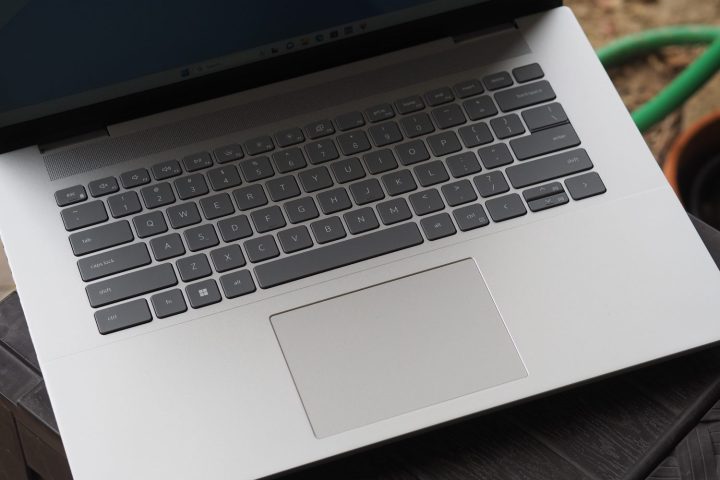
I wasn’t terribly fond of the Inspiron 16 Plus’ keyboard, which felt a bit loose to me. It has deep enough travel and plenty of key spacing, but I prefer the snappier keyboard on the HP Envy 16. Certainly, it’s quite a bit behind the best keyboards on Dell’s XPS machines and Apple’s MacBooks. The touchpad was smaller than it could have been, with plenty of available palm rest space for a larger version, but it was responsive and its buttons were precise and not too loud.
A mix of Thunderbolt 4 and legacy ports make for good connectivity. I’d like to have seen one more of the former, and for some reason, the RTX 4060 version comes with a miniSD card reader rather than the full-size reader on the other models. Wireless connectivity is fully up to date.
Finally, the webcam runs at 1080p and provides a good image for videoconferencing. There’s no infrared camera for Windows 11 Hello facial recognition, but the fingerprint reader embedded in the power button worked fine. There’s a physical shutter for the webcam for some privacy.
Competitive performance, unpredictable battery life

I reviewed the Inspiron 16 Plus with the fastest available components: a 45-watt Intel Core i7-13700H with 14 cores (six Performance and eight Efficient running at up to 5GHz) and 20 threads. It’s a common workhorse CPU for 16-inch laptops and promises solid performance. The Nvidia GeForce RTX 4060 in my review unit also promises good performance in creative apps.
In our CPU-intensive benchmarks, the Inspiron 16 Plus performed as expected in all but the Cinebench R23 benchmark, where it fell slightly behind the Dell XPS 15 with the same chip. In the Pugetbench Premiere Pro benchmark, which runs in a live version of Adobe’s Premiere Pro and uses the GPU to speed up various processes, the Inspiron 16 Plus lagged the Dell XPS 15, but was competitive with the MSI Prestige 16 Studio. The HP Envy 16 was a lot faster, but it also benefitted from a faster CPU in a much more expensive configuration.
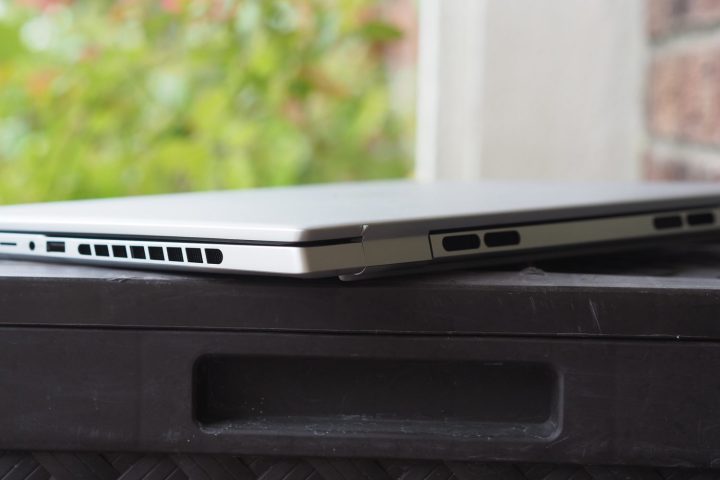
Overall, the Inspiron 16 Plus performs well for a midrange 16-inch laptop. It will power through demanding productivity workflows while meeting the needs of most creators. One downside is heat; the Inspiron 16 Plus got very hot during benchmark runs, on the top of the palm rest and on the underside of the chassis. And that’s with the (sometimes annoying) fans running at full blast.
| Geekbench
(single / multi) |
Handbrake
(seconds) |
Cinebench R23
(single / multi) |
Pugetbench
Premiere Pro |
|
|
Dell Inspiron 16 Plus
(Core i7-13700H/RTX 4060) |
Bal: 1,812 / 12,309
Perf: 1,773 / 12,693 |
Bal: 74
Perf: 79 |
Bal: 1,855 / 12,480
Perf: 1,867 / 13,535 |
Bal: 767
Perf: 814 |
|
HP Envy 16 (2023)
(Core i9-13900H/RTX 4060) |
Bal: 1,997 / 12,742
Perf: 1,992 / 12,645 |
Bal: 73
Perf: 75 |
Bal: 1,944 / 15,596
Perf: 1,954 / 15,422 |
Bal: 1,106
Perf: 1,121 |
|
MSI Prestige 16 Studio
(Core i7-13700H/RTX 4060) |
Bal: 1,880 / 6,951
Perf: 1,903 / 11,945 |
Bal: 139
Perf: 80 |
Bal: 1,797 / 7,959
Perf: 1,921 / 13,647 |
Bal: 668
Perf: 865 |
|
Dell XPS 15 (9530)
(Core i7-13700H/RTX 4070) |
Bal: 1,787 / 11,978
Perf: 1,830 / 11,769 |
Bal: 79
Perf: 76 |
Bal: 1,865 / 13,386
Perf: 1,868 / 13,927 |
Bal: 866
Perf: 1,023 |
|
Dell XPS 17 (9730)
(Core i7-13700H/RTX 4070) |
Bal: 1,901 / 12,654
Perf: 1,928 / 12,911 |
Bal: 79
Perf: 71 |
Bal: 1,933 / 13,384
Perf: 1,912 / 15,462 |
Bal: 760
Perf: 848 |
| Apple MacBook Pro 14 (M2 Max 10/38) | Bal: 1,973 / 14,596
Perf: N/A |
Bal: 85
Perf: N/A |
Bal: 1,608 / 14,789
Perf: N/A |
Bal: 1,093
Perf: N/A |
The Inspiron 16 Plus performed relatively well in our suite of gaming benchmarks, falling a little short of the HP Envy 16. but not by much. And of course, the HP equipped a faster CPU, making the Dell’s performance in Civilization VI that much more impressive. It was also faster than the Dell XPS 15 with the RTX 4070, but in that case, the GPU was significantly underclocked.
You’ll get solid 1080p gaming out of the Inspiron 16 Plus and can stretch that to 1440p if you turn down the graphical detail.
| Assassin’s Creed
Valhalla (1080p/1200p Ultra High) |
Cyberpunk
2077 (1080p/1200p Ultra) |
Civilization VI
(1080p Ultra) |
3DMark
Time Spy |
|
|
Dell Inspiron 16 Plus
(RTX 4060) |
Bal: 101 fps
Perf: 101 fps |
Bal: 65 fps
Perf: 79 fps |
Bal: 147 fps
Perf: 147 fps |
Bal: 9,086
Perf: 9,296 |
|
HP Envy 16 (2023)
(RTX 4060) |
Bal: 100 fps
Perf: 108 fps |
Bal: 78 fps
Perf: 83 fps |
Bal: 149 fps
Perf: 158 fps |
Bal: 9,366
Perf: 9,765 |
|
MSI Prestige 16 Studio
(RTX 4060) |
Bal: 35 fps
Perf: 108 fps |
Bal: 64 fps
Perf: 74 fps |
Bal: 105 fps
Perf: 131 fps |
Bal: 7923
Perf: 7386 |
|
Dell XPS 15 (9530)
(RTX 4070) |
Bal: 65 fps
Perf: 105 fps |
Bal: 60 fps
Perf: 60 fps |
Bal: 131 fps
Perf: 137 fps |
Bal: 7,077
Perf: 7,632 |
|
Dell XPS 17 (9730)
(RTX 4070) |
Bal: 88 fps
Perf: 94 fps |
Bal: 75 fps
Perf: 77 fps |
Bal: 155 fps
Perf: 159 fps |
Bal: 9,639
Perf: 9,535 |
|
MSI Creator Z17 HX Studio
(RTX 4070 Ti) |
Bal: 66 fps
Perf: 101 fps |
Bal: 61 fps
Perf: 90 fps |
Bal: 149 fps
Perf: 191 fps |
Bal: 10,186
Perf: 11,630 |
You don’t expect great battery life from a laptop with a large, high-resolution display, a fast CPU, and a discrete GPU. There are exceptions, such as the Dell XPS 15 with its decent longevity and the Apple MacBook Pro 16 that lasts forever on a charge. But if you can make it to lunch, you’re hitting the average for this class of devices.
The Inspiron 16 Plus was hard to gauge. First, it lasted longer in our web-browsing test than it did in our video-looping test, which is unusual. And it wouldn’t complete the PCMark 10 Applications battery test that’s the best measure of productivity longevity. Going by the numbers we have, I’d say battery life is just OK, and it won’t come close to lasting a full day on a charge.
| Web browsing | Video | |
| Dell Inspiron 16 Plus (Core i7-13700H) | 9 hours, 8 minutes | 7 hours, 36 minutes |
|
HP Envy 16 (2023)
(Core i9-13900H) |
5 hours, 56 minutes | 7 hours, 47 minutes |
|
Dell XPS 15 (9530)
(Core i7-13700H) |
9 hours, 43 minutes | 11 hours, 46 minutes |
|
Dell XPS 17 (9730)
(Core i7-13700H) |
4 hours, 46 minutes | 5 hours, 17 minutes |
|
Apple MacBook Pro 16
(Apple M1 Pro) |
18 hours, 35 minutes | 23 hours, 11 minutes |
The display’s not for creators, and there’s no better option
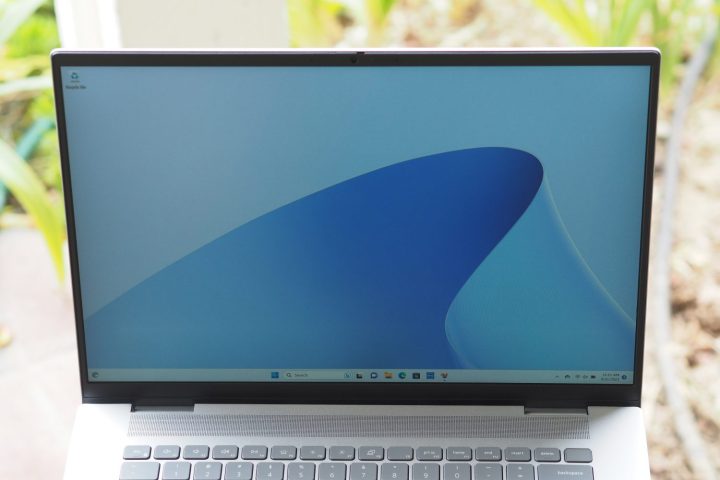
The Inspiron 16 Plus will eventually offer two display options, both 16.0 inches at the productivity-friendly 16:10 aspect ratio. The Full HD+ IPS panel at 60Hz isn’t available yet, but will theoretically lower the price. My review unit was equipped with the high-end display, a 2.5K IPS display running at a speedy 120Hz.
According to my colorimeter, the Dell panel wasn’t as bright as the HP Envy 16’s display with the same specs, but it offered a significantly higher contrast ratio and just slightly wider colors. Both displays had excellent color accuracy close to the DeltaE of 1.0 that means color differences can’t be viewed by the human eye.
That makes the Inspiron 16 Plus’ display very good for productivity users but without the wide color gamuts demanded by creators. The problem is that there’s no better option, while the Envy 16 has a 2.8K OLED display available that is likely to offer extremely wide colors. You’ll spend more for that option, but at least it’s available.
| Brightness (nits) | Contrast | sRGB gamut | AdobeRGB gamut | Accuracy DeltaE (lower is better) | |
| Dell Inspiron 16 Plus (IPS) | 308 | 1,510:1 | 98% | 76% | 1.19 |
|
HP Envy 16 (2023)
(IPS) |
395 | 1,010:1 | 97% | 73% | 1.01 |
|
Dell XPS 15 9530
(OLED) |
358 | 24,850:1 | 100% | 96% | 1.31 |
|
Dell XPS 17 9730
(IPS) |
501 | 1,570:1 | 100% | 100% | 1.33 |
|
MSI Prestige 16 Studio
(mini-LED) |
455 | 3,140:1 | 98% | 82% | 3.46 |
|
Apple MacBook Pro 16
(XDR) |
475 | 475,200:1 | 100% | 90% | 1.04 |
Audio duties are performed by a set of quad speakers, two upward-firing above the keyboard and two downward-firing on the bottom of the chassis. The sound was crisp and clear at full volume, with nice highs and mids, but almost no bass. The biggest problem is that the audio just didn’t get very loud. It’s fine for the occasional YouTube video and such, but if you want to enjoy your streaming media and music, you’ll want to plug in a good pair of headphones.
A decent laptop that just falls short
The Inspiron 16 Plus falls just short of being a laptop that I can comfortably recommend. It provides good performance for all but the most demanding creators, but it doesn’t offer a display option that meets their needs. It’s priced like a premium laptop, but it’s not built like one. You expect a metal chassis and lid when you’re spending around $1,500 or more, not plastic.
If you’re a productivity user who wants a really fast laptop, then it’s an option. But so are many other 16-inch machines. The HP Envy 16 is close in price with a similar configuration, but it feels like a more premium laptop. In the end, I’d say to pass on this one unless its price comes down considerably.


